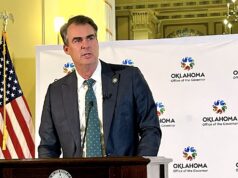
˝As University of Oklahoma President Joe Harroz announced plans to develop a new Polytechnic Institute in Tulsa, he referenced Purdue Polytechnic Institute in Indiana and nodded toward OU Vice President for Research and Partnerships Tomás Díaz de la Rubia during today’s Board of Regents meeting.
“Probably the source of the idea was from Tomás,” Harroz said, referencing Díaz de la Rubia’s employment at Purdue from 2015 to 2019.
Díaz de la Rubia laughed and said, “You think?”
Board members are expected to review more details and establish a timeline for the new Polytechnic Institute’s development at their June meeting, but the university hopes the concept will provide significant returns on investment for the state’s economy, its workforce, its business community and the education landscape in Tulsa.
“We are so thankful for the support shown for this idea by Gov. Stitt, the speaker of the House and the president pro tempore of the Senate,” Harroz said, perhaps referencing what could be a significant investment of appropriations for higher education next fiscal year.
Harroz said the new institute will serve graduate students and undergraduate students, with degree programs in areas such as computer science, information technology, digital manufacturing, electric vehicles and artificial intelligence and autonomous technology.
“When you look at the jobs I listed, their average starting salary is between $62,000 and $75,000 a year,” Harroz said, noting that OU’s own Information Technology department has numerous open positions that it is struggling to fill.
Undergrads will need to complete their first two years at another institution such as Tulsa Community College, Rose State College or Oklahoma City Community College. (OU has recently streamlined its transfer agreements with those colleges and Tarrant County College in Texas.)
‘Can you supply the workforce?’

As managing partner of the private equity firm Acorn Growth Strategies, OU regent Rick Nagel currently has investments in a company that works with Florida Polytechnic University.
“The graduates who come out of there are degreed and workforce-ready in areas of applied science that are incredibly useful to our company and all of the employers in the region who have an insatiable need for engineering talent. They can hit the ground running,” Nagel said after Friday’s meeting. It’s not only about getting young people right into the workforce, but think about workforce retraining as well, where college degrees are required for skills that are cutting edge and kind of tip of the spear, if you will, in terms of technology.”
Nagel said OU is working to increase transfer student enrollment, and he said two more admission agreements with regional community colleges are in the works.
“They’ll apply, and the idea will be that we will feather those students in and get them topped off,” Nagel said after Friday’s meeting. “This is really going to be a game changer for our state and could be a model for our state as we talk about economic development being corner to corner and border to border.”
Nagel pointed to the state’s broader efforts to recruit businesses of the future to Oklahoma.
“When you look at economic development activities of our state and how much is moving to northeast Oklahoma, whether it be Canoo or other things we’ve been talking about like Project Ocean, those require technologists, computer programmers, scientists and engineers at a scale our current universities cannot support,” Nagel said. “We need to have another outlet that is aligned with the career requirements of those employers.”
Harroz agreed.
“We check every box for being a great place to come. And then it comes to, ‘Can you supply the workforce for these technology-specific jobs?’ And that’s the hard stop for all of them. So this is an effort to address that,” Harroz said. “We don’t even have enough to meet the needs of the businesses we have right now, but the schools that have done this well become magnets for those enterprises to come to the state.”
Díaz de la Rubia said that has been the result with Purdue Polytechnic Institute, which was launched about a decade ago.
“It was to fill this gap in the types of graduates that universities create in applied science and technology. Graduates who have a very experiential, project-based education that can go directly into the workforce with very high-paying jobs to implement and apply advanced technologies, which are transforming businesses today,” Díaz de la Rubia said. “It’s also impactful to the state of Indiana, and that is part of our vision here. They are able to recruit a lot of students, obviously from Indiana but also from around the country. Very early on in their curriculum, they work with companies on specific projects.”
He said the Purdue Institute has about 5,000 students, with about 1,000 graduating annually. He said the applied sciences being taught prepare a workforce for “the fourth industrial revolution.”
“It’s both a brain gain by bringing those students into the school, and it’s a retention mechanism because of the very, very close tie between businesses and the Polytechnic Institute,” he said.
‘An incredibly complicated higher education landscape’

In discussing OU’s new effort, Harroz and Nagel both noted the unusual situation that Tulsa has long faced in terms of public institutions of higher education. Although TCC, OU, Oklahoma State University, Langston University and Northeastern State University all have a presence in the Tulsa metro area, historic complications have made it difficult for Oklahomans to find a simple and direct path to a four-year degree without having to move or go to a private university.
“Tulsa is such an incredibly complicated higher education landscape. It’s complicated by law, it’s complicated by policy, and it’s complicated by tax policy that exists there as well,” Harroz said. “So there are structural reasons that it has been difficult to figure out what to do in Tulsa, and there is a reason that Tulsa hasn’t had the opportunity of a really robust four-year research public university. It’s legal, it’s structural, it’s policy.”
Nagel said he has learned more of that history since being appointed to the OU board last year by Gov. Kevin Stitt.
“What’s been interesting to me as a regent coming on board is that, for whatever combination of reasons — territorial, political, legal, structural — the city of Tulsa does not have a public four-year degree completion center,” Nagel said.
He noted that past efforts have not exactly had the desired results.
“This will finally give Tulsa and all of northeast Oklahoma what they have needed and have been desperately asking for for decades,” Nagel said.
(Correction: This article was updated at 4:40 p.m. Friday, May 13, to correct reference to enrollment numbers at Purdue Polytechnic Institute.)




















